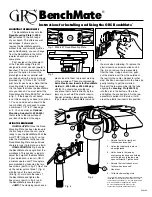
004-109
MOUNTING THE BENCHMATE
The BenchMate locks onto the
Fixed Mounting Plate (I. #004-
557)
attached to the front edge
of your bench. This offers several
advantages. It allows you to
remove the BenchMate quickly,
without tools, and reinstall it just as
easily. Additionally, you can change
from the BenchMate to the GRS
jeweler’s bench pin using this
same plate.
First, decide on the placement
of the Fixed Mounting Plate (it’s
designed for most wooden jeweler’s
benches). The six countersunk holes
give you the option to mount the
plate higher, lower or parallel with
your bench using the 4 wood screws
provided (fig. 1). Drill a 1/16” to 3/32”
pilot hole for each screw. Note that the
mounting plate is tapered two ways.
It is the taper that locks the BenchMate
onto your bench. You must install the
Fixed Mounting Plate EXACTLY as shown
in fig. 1. If the edge of your bench
is not thick enough you have two options:
1. You can add an extra board to the
top or bottom of your bench to make
a combined 1 1/2” to 2” thick edge
or, 2. You can order an Optional
Mounting Adapter (H. #004-559)
that screws to the top surface of
your bench instead of the edge.
USING THE BENCHMATE
INSTALLATION:
Once the Fixed
Mounting Plate has been fastened to
the front edge of your bench, you’re
ready to use the BenchMate. With the
word “TOP” (shown in fig. 2) on top,
slide the BenchMate firmly over the
Fixed Mounting Plate and pull down
sharply to lock it into plate, see fig. 3.
IDEAL POSITION:
Fig. 5 shows
the BenchMate at an angle from the
workbench. This position is ideal to
adjust the height of the BenchMate
if your workbench is too tall -OR- if
a microscope is used. This angle is
accomplished by loosening the two
hex screws (part A in fig. 5). Next, line
up the center point of knob 1 (fig. 4)
with the top of the work surface
(B in fig. 5). Hold onto the tube of
the BenchMate and tighten the
hex screws (part A in fig. 5) until
the BenchMate is secure again.
JAWS: The clamping jaws have a
plastic insert in them to prevent marring
of the workpiece. These are replaceable,
Extra Plastic Jaw Inserts for BenchMate
Holder (L. #004-090 or #004-558 pkg.
of 10)
. You should never solder on
any piece that is held in directly by the
jaws or you will melt the plastic inserts.
Special soldering clamps are available
to go between the BenchMate jaws and
the work when soldering. To replace the
plastic inserts, unscrew knurled knob 3
(fig. 4) and remove the jaw assembly
from the tube. Using a small rod, push
out the plastic insert from the outside of
the jaw into the center. Repeat for other
side. Position new inserts into the holes by
gently twisting to get them started.
Re-insert the jaw assembly into the tube,
aligning the
Locating Pin (#002-769)
into the slot in the bottom of the tube
and tighten the knurled knob. As the jaw
assembly is pulled into the tube, it will
press the plastic jaw inserts into position.
BenchMate
®
Instructions for Installing and Using the GRS BenchMate
®
Fig. 1. #004-557 Fixed Mounting Plate
Fig. 2
1 - Adjusts the left to right pivot
friction when loosened *
2 - Holds the tube firmly in place
when tightened
3 - Holds items in the jaws by
unscrewing the knob and holding
onto the tube until the jaws are
open sufficiently. Tighten knob.
4 - Adjusts the front to back pivot
friction when loosened *
5 - Hand rest
6 - Third Hand mounting slots
*If you prefer a stiffer pivot, the black friction washer
(#004-089) can be removed from either pivot -OR-
remove the knob assembly (1 & 4) and replace with
3/8 - 24 hex bolts for a tighter pivot. NOTE:
Do not overtighten with the wrench or you
could crack the plastic washer (#004-091).
Fig. 4
Fig. 3
Fig. 5




